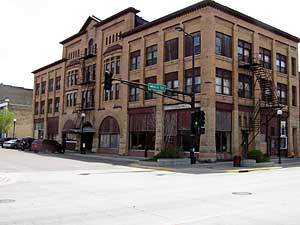|
Photos
|
July 6, 2005
Crookston is the county seat of Polk County, more than 8,000 people call it home. Unlike other towns of similar size, there are no so-called big box stores here, no national discount chains. Crookston's identity is its downtown. Most of the retailers are here and it's where you'll find a large number of buildings on the National Historic Register. The buildings are at the heart of a debate over the economic future of the town.
Crookston, Minn. — When you drive into Crookston in northwest Minnesota, it's hard not to notice the many old buildings downtown. Some of the structures appear to be in good shape while others sit empty and decaying.
Most of Crookston's downtown is included in the National Register of Historic Places. It's a fact that complicates the city's efforts to revive its struggling retail businesses.
Some see the Union building, built in 1890, as just another relic, others like Kay Hegge see an unpolished jewel.
"It has the original pressed tin ceiling in the main floor and in the basement," says Hegge.
Hegge is the new owner of the Union building, she decided to buy the place when the previous owner retired. The property was about to be claimed by the county for nonpayment of taxes.
The Union building isn't her only project. Hegge organized the Skyline Preservation Foundation. The group is trying to preserve other historical buildings, like the old Crookston Cathedral and the Wayne Hotel.
Hegge believes the old structures are worth saving, not only for historical value but also as a way to restructure the town's retail economy. Hegge says restoring the old buildings is a way to make the city a tourist destination. Hegge envisions the restored buildings housing unique shops and she thinks people will gladly pay to tour old historic buildings.
Hegge argues, Crookston has to establish a new identity for its downtown. She contends it's unlikely that traditional businesses like clothing or grocery stories will be attracted to the space.
"It could be local art, we could have museums, and we could be a tourist destination," says Hegge. "We're just going to have to think very much towards the future and not the past, because I don't think it will be that way anymore."
Hegge knows the idea is a tough sell and she concedes there's no guarantee the approach will work, but she thinks it's worth the gamble. She says it's difficult for traditional retailers to compete with bigger stores in nearby Grand Forks.
Hegge says there are state and federal grants available for historic preservation, however the paperwork is complicated and takes time. Hegge believes city and county officials aren't doing enough.
Polk County Commissioner Bill Montague says it's not that simple. Montague notes everyone likes the idea of saving the old buildings.
"But to get something put together locally, to get it started, so we can apply for state and federal grants possibly to help with the remodeling, I just don't see that happening locally," says Montague. "Lots of people want to save it, but not many want to come up with any money to do it."
Montague would like to see the buildings restored, especially the Wayne Hotel. He notes at one time the Wayne was an impressive site. From the outside the three-story brick building looks fine, but the building has been empty for many years. The roof leaks, there's mold and water damage to the floors.
Montague says the Wayne Hotel is a tax-forfeited property, one of two in the historic district. The owner abandoned the building, no one is paying property taxes and now the building belongs to the county. Instead of generating revenue it's tapping into already tight budgets. Estimates on the cost of restoring the Wayne run as high as $4 million. The county doesn't have the money to spare and neither does the city of Crookston, according to Aaron Parrish the city administrator.
"Of all the property taxes we generate in a given year is $1.6 million," says Parrish. "To say we're going to take three years of our levy and do one building is obviously not feasible."
Parrish knows there are grants available to help offset the costs, but there are stipulations attached to the money.
"You also have to reuse the building consistent with what it's original purpose was and in a lot of these cases its commercial," says Parrish. "So when you go to reuse, where you're going to go from commercial to housing, which is a great opportunity for us, you have limited ability to access federal and state dollars. Because you have to maintain the original use."
Parrish says there are 24 buildings in the downtown area that have a historic designation. He says the community needs to make some tough decisions.
He agrees the historic district will be a vital part of the city's future, however the hard part will be deciding how much of it the community can afford to keep.








